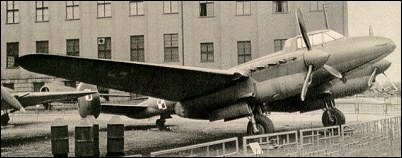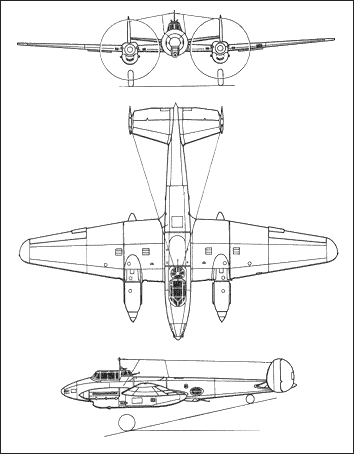|
| Arriving in small numbers in the ranks
of the V-VS to witness the mass devastation
of the summer of 1941, the
Petlyakov Pe-2 was destined to become
the best Soviet light bomber of
World War II. The aircraft was derived
from V.M. Petlyakov's VI-100 pressurized
high-altitude twin-engined interceptor,
which displayed a phenomenal
top speed of 623km/h at
10,000m, had a crew of two
and was powered by 820kW M-105R V-12 engines. The VI-100
first flew on 7 May 1939. With the
approach of war in Europe the V-VS
made urgent requests for dive-bomber
aircraft, and to this end the
design bureau adapted the VI-100
fighter by removing the TK-3 high-altitude
turbo-chargers, fitting standard
M-105R engines, lattice type
dive-brakes, and giving the tailplane
pronounced dihedral to increase stability.
Two prototype PB-100 (pikiruyushchn
bombardirovshchik, or
dive-bomber) aircraft were built with
these items installed in addition to an
extensively glazed nose and defensive
armament. This type became the Petlyakov
Pe-2 light bomber and dive-bomber.
The crew of three (pilot,
bombardier and air-gunner) sat under
a long glazed canopy with 9mm armour protection. Initial armament
consisted of two fixed 7.62mm ShKAS guns in the nose, one in the
dorsal station, and a fourth in the ventral
aimed by a 120° vision periscope.
The M-105R engines drove three-bladed
VISh-61 propellers. The aircraft
proved to be fast, highly manoeuvrable,
but was guite demanding
to novice pilots under asymmetric conditions.
By the time of the German invasion
in June 1941 some 458 Pe-2s had
been produced from the factories, but
it is suspected that deliveries to service
units was tardy. Certainly, even
by September 1941 the numbers of Pe-2s in front-line units were few. Colonel
General I.S. Konev's Western Front
had only five in commission with which
to stem the German assault on Moscow,
and the establishment of Pe-2s
with the Bryansk and Kalinin Fronts
was even lower. Although limited in
numbers, Pe-2s contributed to the victories
of the Soviet winter offensive of
1941-2, and were seen in increasing
numbers during the defensive battles
at Leningrad, Kharkov, Rostov, and in
the Stalingrad campaign. Late in 1942
came the improved Pe-2FT with 940kW Klimov M-105PF engines,
and a 12.7mm UBT machine-gun
in a dorsal turret. The Pe-2I and
Pe-2M were fighter-bombers, powered
by 1208kW VK-
107A engines. The reconnaissance
version was the Pe-2R, whilst a dual-control
trainer was termed the Pe-2UT.
The aircraft saw distinguished service
in every major Soviet campaign from
1941 to 1945, including operations in
Manchuria against the Japanese in
September 1945. A total of 11,427 Pe-2s
and Pe-3s (the fighter version) was
produced.

| CREW | 2 |
| ENGINE | 2 x VK-105PF, 920kW |
| WEIGHTS |
| Take-off weight | 8520 kg | 18783 lb |
| Empty weight | 5870 kg | 12941 lb |
| DIMENSIONS |
| Wingspan | 17.2 m | 56 ft 5 in |
| Length | 12.7 m | 42 ft 8 in |
| Height | 4.0 m | 13 ft 1 in |
| Wing area | 45.5 m2 | 489.76 sq ft |
| PERFORMANCE |
| Max. speed | 581 km/h | 361 mph |
| Cruise speed | 480 km/h | 298 mph |
| Ceiling | 8800 m | 28850 ft |
| Range w/max.fuel | 1200 km | 746 miles |
| ARMAMENT | 3 x 12.7mm machine-guns, 2-4 7.62mm machine-guns, 600-1000kg of bombs |
| Klaatu83, e-mail, 18.02.2017 23:08 One of the best tactical aircraft of WW-II. The Pe-2 was not quite equivalent to the Mosquito, which was never really intended for the front-line ground-attack role. The British aircraft that performed a role more similar to that of the Pe-2 would have been the Hawker Typhoon. Perhaps the closest western equivalent to the Pe-2 was really the Douglas A-20 "Havoc", which was designed to fulfill the same role of tactical support to the front-line ground troops as was the Pe-2 even although, in actually operation, the A-20 was rarely employed in that manner. reply | | Paul Scott, e-mail, 16.07.2016 20:11 Very similar look to the Mig-5 reply | | Mark, e-mail, 20.09.2012 17:37 Petlyakov Pe-2
Πρόκειται για Σοβιετικό βομβαρδιστικό, με μεγάλη συμμετοχή κατά τον 2ο Παγκόσμιο Πόλεμο. Κατασκευάστηκαν πάνω από 11.000 Pe-2 κατά τη διάρκεια του πολέμου. Ήταν εξαιρετικά αποτελεσματικό, ευέλικτο και ανθεκτικό και χρησιμοποιήθηκε ως βομβαρδιστικό, μαχητικό και αναγνωριστικό
Σχεδιάστηκε από τον Vladimir Petlyakov το 1939 ενώ ήταν κρατούμενος σε στρατόπεδο από τους ίδιους τους Σοβιετικούς. Το πρώτο Pe-2 πέταξε στο τέλος του 1940 ενώ, συμμετείχε στις Σοβιετικές αεροπορικές δυνάμεις σε επιχειρήσεις μετά το 1941. Παραλλαγή του αποτελεί το Pe-3. Αποσύρθηκε το 1954 reply | | Gerry Starkeson, e-mail, 09.08.2012 20:36 One of the best close-support aircraft in the Soviet Air Force WWII reply | |
| | mike, e-mail, 15.11.2011 09:31 the initial mosquitoes did have unsuitable glues for tropical climates but that was speedily rectified and the mosquito was as reliable in hot and steamy climates as it was in northern Europe and the fact it was made of wood was a triumph of British ingenuity and certainly no weakness. reply |
| paul scott, e-mail, 23.08.2009 20:18 I've always liked this aircraft, sometimes referred to as Russia's 'Mosquito'. (Though that didn't mean it was made of wood, nor broke up in the far east!). reply | | Leo Rudnicki, e-mail, 22.06.2009 21:37 Petlyakov designed the Pe-2 in a "designer's prison" where he and his staff were the guests of Lavrenti Beria and the NKVD. Papa Joe wasn't happy with progress on ANT42. He was pleased enough to release him upon completion, although he had to watch the first flight from prison. He got his own design bureau and the Pe-8 was re-designated in his honour. He died in the crash of a Pe-2 early 1942. Tough break. Sometimes, I know how he feels. Myasischev took over the bureau. reply | | federico, e-mail, 22.06.2009 19:32 it's an error. Crew was of 3 man. reply | | Alex, e-mail, 14.06.2009 13:21 If the crew consists of 2 men, who shoots from the under-paunch machine-gun? reply | | Gerry Starkeson, e-mail, 16.01.2007 05:34 I made a paper silhouette model of the Pe2 from parts printed on the back of a cereal box (1944?). I was 3 years old. My first model. reply |
|
Do you have any comments?
|
| 
COMPANY
PROFILE
All the World's Rotorcraft
|









Thanks Mike
reply